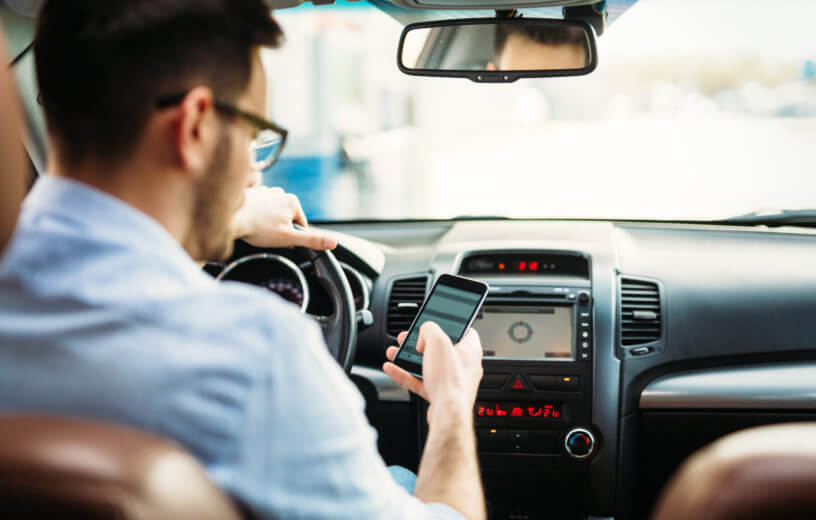How Does Distracted Driving Impact Car Insurance?

April is National Distracted Driving Awareness Month, which means it’s time to take a look at how driving with distractions is not only dangerous for you and others on the road, but also impacts your insurance prices.
Like driving drunk, driving distracted may be a choice you make out of convenience or to save time and effort, but it is extremely risky. Here are some of the facts you might not know about this dangerous habit.
What is Distracted Driving?
Doing anything that takes your eyes and attention off the road increases your risk of getting into a car accident. As defined by the National Highway Traffic Safety Administration (NHTSA), distracted driving occurs when drivers focus on another activity instead of the task of driving.
Sometimes, inattention can be caused by physical and emotional conditions such as fatigue, anxiety, stress, or lack of sleep. It can also be caused by other distractions like cell phones, radios, and other passengers in the vehicle.
Cell phone use is one of the worst culprits in distracted driving. When you send or read a text, you take your eyes off the road for what may feel like a brief moment, but it’s enough time to miss a person on a crosswalk or an animal dart across the road. If you’re driving 55 miles per hour and look at your phone for just 5 seconds, you drive the length of a football field with your eyes virtually shut.
In 2021, there were 377 fatal crashes reported to involve cell phone use as a cause of distraction. This accounts for 12% of all reported distraction-affected fatal crashes that year. A total of 410 people died in crashes involving at least one driver using their cell phone in 2021.
According to the NHTSA, other types of distractions that are often reported include moving objects in their vehicles, adjusting audio and climate controls, manipulating vehicle controls such as lights and windows, reaching for a device or object such as a GPS, events or objects outside of the vehicle, eating, drinking, and smoking.
Distracted Driving Statistics
Distracted driving claims thousands of lives every year. In 2021, a total of 3,522 people died from distracted driving in the US, according to the U.S. Department of Transportation. An additional 362,415 were injured by distracted driving in this year.
According to a report by the NHTSA, 8% of all fatal crashes in 2021 were caused by distracted driving. Also linked to distracted driving were 14% of all crashes that caused injuries and 13% of all police-related motor vehicle traffic crashes.
The age group of 15- to 20-year-olds have the highest likelihood of being involved in an accident caused by distracted driving. While 5% of all drivers involved in fatal crashes in 2021 were reported as distracted at the time, 7% of drivers aged 15 to 20 were reported as distracted. Drivers in this age group made up 16% of drivers reportedly distracted by cell phones in fatal crashes. However, drivers aged 25 to 34 were the most frequent cell phone users, making up 30% of all drivers distracted by cell phones in fatal crashes.
In addition to drivers and passengers, there were 644 nonoccupants—including pedestrians and cyclists—killed by distracted driving incidents in 2021.
Distracted driving also has economic costs. In 2019, the estimated cost of all motor vehicle crashes in the US was $340 billion. Distracted driving accounted for $98 billion of that cost. Included in these totals are the costs of lost productivity, workplace issues, legal and court fees, medical bills, emergency medical services, insurance administration, congestion impacts, and property damage.
Of course, the injuries and deaths caused by distracted driving also cause invaluable losses, severely impacting the quality of life of drivers and those around them, including friends, family, caretakers, and coworkers. When accounting for these costs, it’s estimated that the total value of the societal harm caused by distracted driving in 2019 was $395 billion.
How Does Distracted Driving Impact Auto Insurance?
In addition to losing your license, facing fines, or getting seriously injured, distracted driving can also drive up your car insurance rates.
Your auto insurance rates are calculated based on your risk factors such as where you live, what type of vehicle you drive, and your driving history. States have laws against distracted driving and cell phone use, and if you’re caught driving distracted, it can end up staining your record. If you have received tickets for texting and driving or reckless driving, you’ll most likely end up paying more than other drivers.
Experts estimate that distracted driving is likely the biggest cause of auto insurance losses in the past five years. The premium surcharge is around 6% to 8%, which means that everyone—not just the distracted drivers themselves—is paying more for insurance due to distracted driving habits.
Some insurance companies offer apps that monitor your cell phone use while driving and can reward you with discounts if you stay attentive to the road. If you want a good incentive to prevent yourself from driving distracted, ask your insurer if one of these apps is available to you.
How Can You Help Prevent Distracted Driving?
We all have roles to play in preventing distracted driving with our friends and families. For parents, it’s important that you teach your teens not to look at their phones, radios, and other devices while they’re driving. Remind them to have conversations with their friends about distracted driving, especially if they are driving with their friends. It’s okay to turn down the radio if it’s too loud to focus on the road, even if their friends want to sing along.
Parents also can lead by example by never driving distracted themselves. You can also remind your new drivers that states with graduated driver licensing (GDL), violating distracted driving laws could result in their license being delayed or suspended.
Educators and employers can also help their students or colleagues avoid distracted driving. You can create school or company pledges, and you can also avoid asking your coworkers to take meetings while on the road.
Any of us can also speak out in our communities through supporting local laws against distracted driving and posting on social media to spread awareness.
It’s up to all of us to keep our eyes on the road to keep ourselves and our communities safe.

